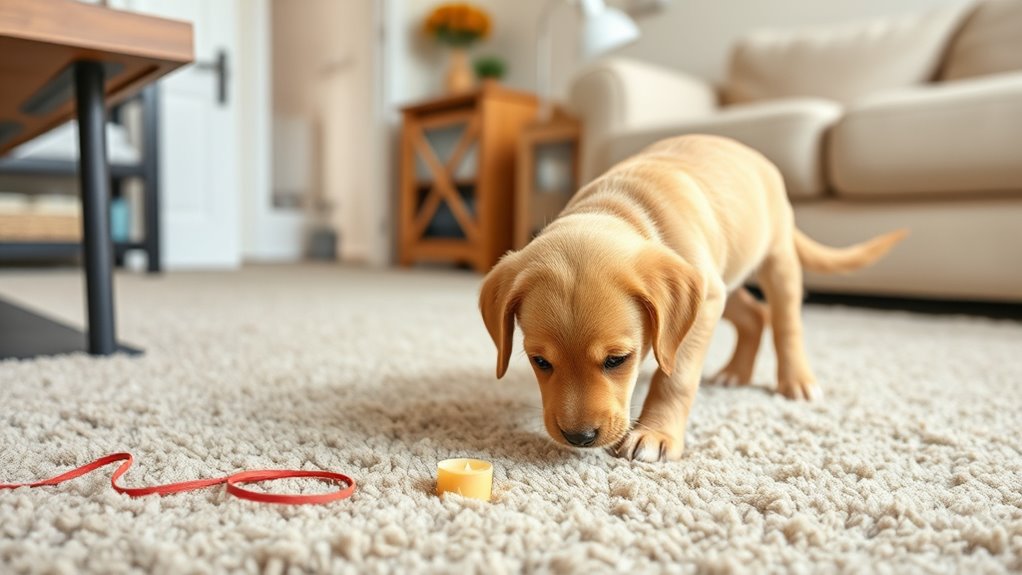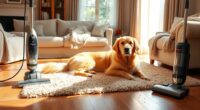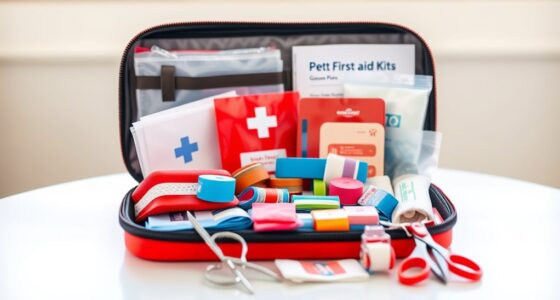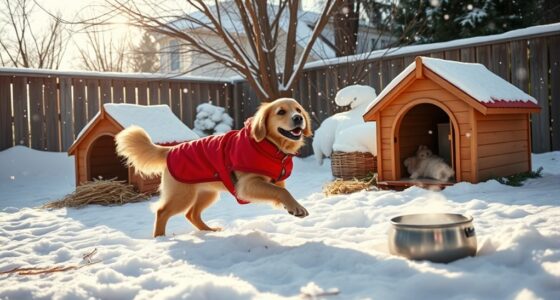To pet-proof your home, start by securing household chemicals in high, locked cabinets with childproof containers. Keep small objects like coins and jewelry out of your pet’s reach, and organize trash cans with animal-proof lids. Remove or replace toxic plants, and prevent access to electrical cords by hiding or securing them. Create designated safe zones for play and rest, and regularly check for hazards such as loose wires or food scraps. Want to guarantee every potential danger is covered? Continue exploring the best safety strategies.
Key Takeaways
- Store household chemicals in high, locked cabinets in original, labeled containers to prevent accidental ingestion or misuse.
- Secure electrical cords with covers or clips and unplug devices when not in use to prevent chewing hazards.
- Remove or replace toxic plants like lilies and Peace Lily with pet-safe greenery such as spider plants.
- Keep trash cans with animal-proof lids and store food in secure, elevated containers out of pet reach.
- Establish designated, clutter-free play and rest areas, regularly inspecting them for hazards and making safety adjustments.
Securing Household Chemicals and Cleaners
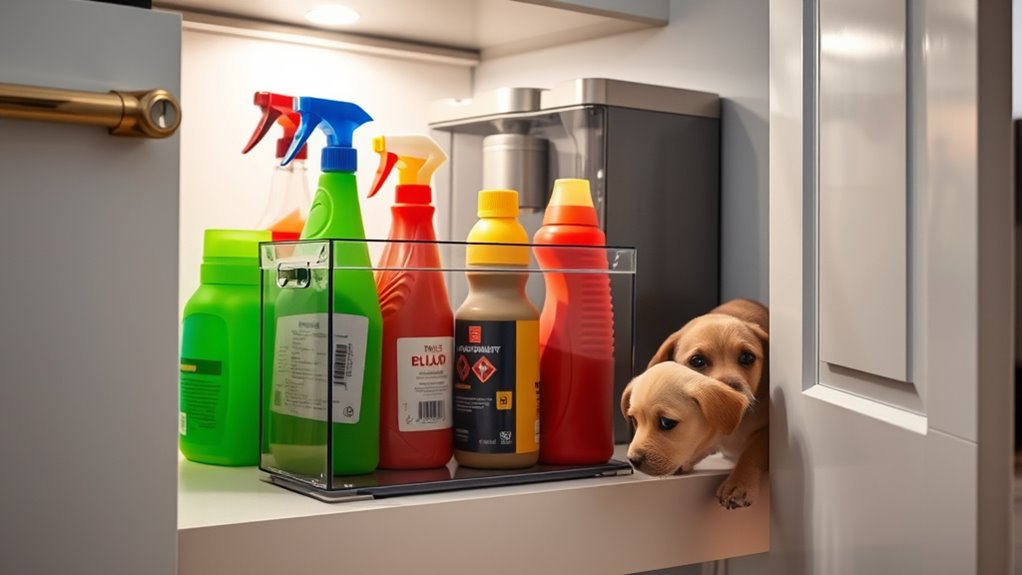
Since household chemicals and cleaners can be highly toxic to pets, it’s essential to store them safely out of their reach. Using childproof storage containers helps prevent accidental spills or ingestion. Ensure that all chemicals are kept in their original containers with clear, legible chemical labeling. This not only helps you identify hazardous substances quickly but also discourages confusion or misuse. Place these items in high cabinets or secure cabinets with locks to maximize safety. Avoid leaving household cleaners in common areas or on countertops, where pets might access them. Regularly check that storage areas remain secure, and educate everyone in the household about the importance of proper chemical storage. Implementing proper storage practices further reduces the risk of accidental exposure, which markedly decreases your pet’s risk of poisoning or injury. Incorporating mindfulness techniques, such as visualizing a safe environment, can also enhance your vigilance in maintaining a hazard-free space. Additionally, considering hazardous household substances and their potential risks can help in developing comprehensive pet-proofing strategies.
Keeping Small Objects Out of Reach
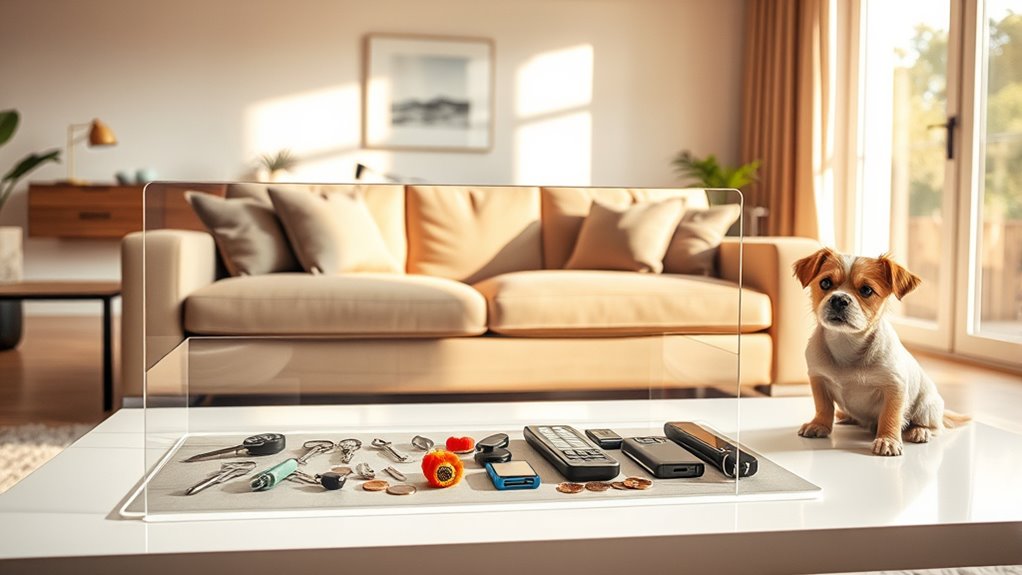
Small objects can pose serious choking hazards or cause internal blockages if pets swallow them, making it essential to keep these items out of their reach. To prevent small object hazards, follow these steps:
- Store small items like coins, jewelry, and keys in secure containers or cabinets.
- Regularly inspect your home for tiny objects left on counters, floors, or furniture.
- Use pet-proof storage solutions for toys, ensuring they’re appropriate for your pet’s size, enhancing pet toy safety.
- Incorporate AI-powered home safety tools that can detect and alert you to potential hazards around the house.
- Be aware that small object detection systems can help identify hidden dangers before pets access them.
Keeping small objects away from pets reduces the risk of accidental ingestion and helps maintain a safe environment. Always supervise playtime and choose toys designed for your pet’s size to further prevent hazards. Staying vigilant about small object hazards is key to pet-proofing your home effectively.
Managing Electrical Cords and Devices
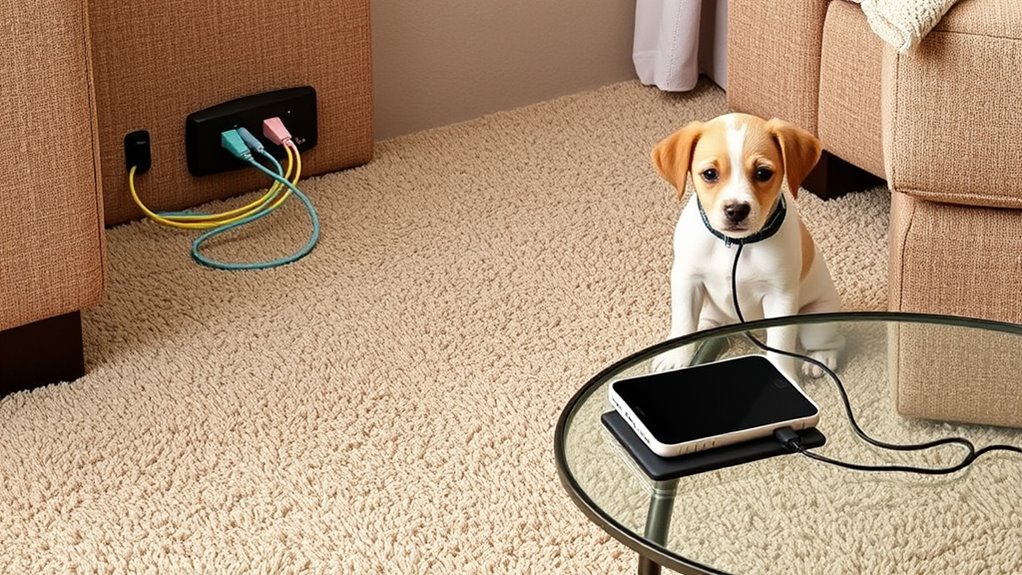
Electrical cords and devices can pose significant risks to your pets if left unmanaged, as they may chew on wires or accidentally knock over devices, causing injury or damage. To ensure device safety and effective cord management, keep cords hidden or secured. Use cord covers or clips to prevent pets from chewing or pulling on wires, and unplug devices when not in use. Setting up designated charging stations can also help minimize clutter and hazards. Additionally, utilizing pet-proofing methods recommended by veterinarians can further reduce potential dangers.
Identifying and Removing Toxic Plants
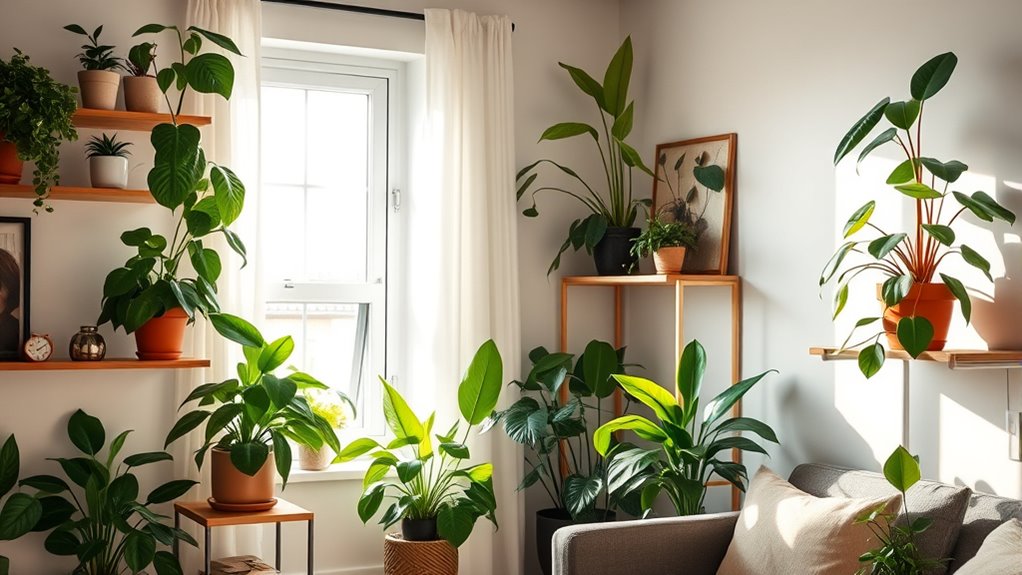
Many common household plants can be toxic to your pets, so it’s important to identify them and remove any that pose a risk. Luckily, there are safe plant alternatives you can choose instead. Knowing which plants to avoid helps keep your furry friends safe and your home beautiful.
Common Toxic Plants
Have you ever wondered which common houseplants could pose a danger to your pets? Many household plants feature poisonous foliage that can cause serious harm if ingested. To keep your pets safe, identify and remove harmful greenery promptly. Here are three common toxic plants to watch out for:
- Dieffenbachia (Dumb Cane) – Contains insoluble calcium oxalates that cause oral irritation and swelling.
- Sago Palm – All parts are toxic, leading to vomiting, seizures, and liver failure.
- Peace Lily – Causes mouth irritation, difficulty swallowing, and vomiting. Additionally, understanding safe plant choices can help create a pet-friendly environment in your home.
Safe Plant Alternatives
Wondering how to keep your home safe for your pets? One effective step is choosing safe plant alternatives for your pet-friendly garden. Replace toxic plants with non-toxic foliage that won’t harm your furry friends if they nibble on them. Look for pet-friendly garden options like spider plants, Boston ferns, or areca palms, which are safe and add beauty to your space. Avoid plants like lilies, philodendrons, or azaleas that can be toxic. When selecting new plants, double-check their safety for pets. Creating a safe environment means removing hazards and opting for non-toxic foliage that satisfies your garden’s aesthetic while keeping your pets protected. Incorporating beneficial plants can further enhance your garden’s health and safety. Understanding that attention in creative practice can help you select the best plants for your home environment is also beneficial. Conducting thorough research on pet-toxic plants ensures you make informed choices. This simple change makes your home a safer, more welcoming space for everyone.
Creating a Safe Space for Play and Rest
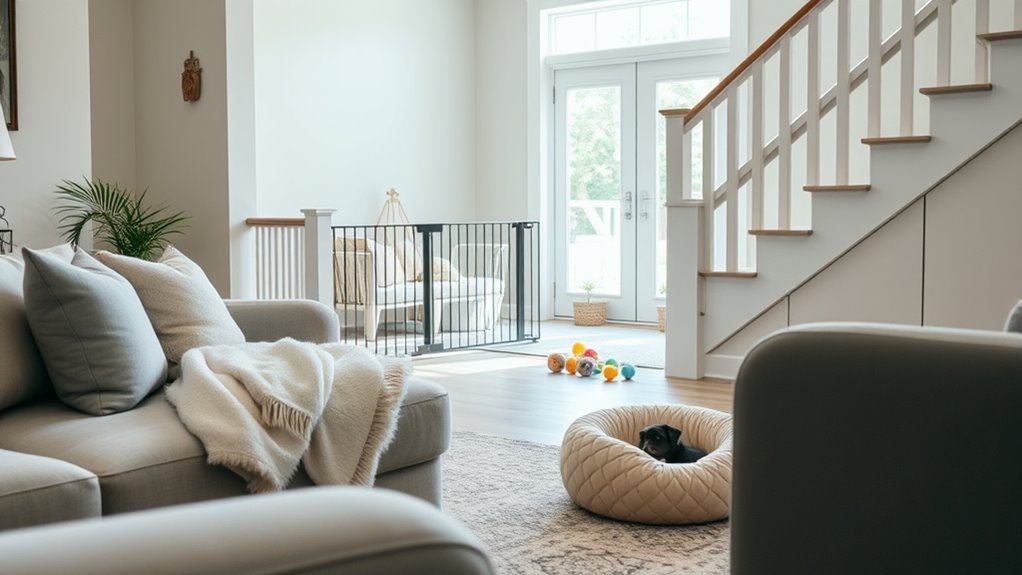
You should set up designated play zones and comfortable rest areas for your pet to keep them safe and happy. Clear boundaries help prevent them from getting into trouble or chewing on unsafe objects. Creating these spaces makes it easy for your pet to relax and enjoy their environment. Additionally, understanding privacy and cookie usage can help you better manage your online interactions and protect your personal information. Using self watering plant pots in your home can also reduce the need for frequent watering, limiting potential hazards like water spills or overwatering that could harm curious pets. Incorporating lifestyle adjustments such as setting routines can further support your pet’s safety and well-being. Regularly inspecting your home for common household hazards can help identify and eliminate dangers before your pet encounters them. Being aware of hazardous household items like certain cleaning supplies and small objects can further enhance your pet-proofing efforts.
Designate Play Zones
Creating designated play zones is essential for keeping your pet safe and minimizing chaos around your home. To do this effectively, focus on these steps:
- Dog proofing furniture by removing or securing items that could be knocked over or chewed, ensuring your pet’s safety.
- Using pet safe decorations to decorate the area, avoiding anything toxic or easily ingested.
- Establishing boundaries with baby gates or playpens to contain your pet within the designated space.
- Incorporating secure mounting techniques to ensure that any fixtures or decorations within the play zone remain stable and safe for your pet.
- Regularly inspecting and maintaining the area helps prevent hazards caused by wear or accidental damage. Understanding family dynamics can also contribute to creating a more harmonious environment for both pets and family members.
- Being aware of dream symbols related to safety or danger can help pet owners recognize potential hazards in their environment or subconscious concerns about their pet’s well-being. Additionally, recognizing dog breeds, such as the friendly Golden Retriever or the intelligent Poodle hybrid, can help tailor the safe environment to your pet’s specific needs.
A well-defined play zone helps prevent accidents and protects your furniture. It also creates a controlled environment for your pet to play and rest comfortably. Consistently maintain and clean the area to promote safe and enjoyable playtime.
Establish Rest Areas
Designating a dedicated rest area for your pet guarantees they have a safe, comfortable space to relax and recharge. A well-planned rest area setup encourages pet relaxation and prevents them from wandering into unsafe zones. Choose a quiet corner or cozy spot with soft bedding, away from high-traffic areas or household hazards. Keep the space clean and free of clutter, ensuring it remains inviting and stress-free. Incorporate familiar items like a favorite blanket or toy to make it feel secure. Establishing this designated space helps your pet understand where they can unwind, reducing anxiety and encouraging healthy rest habits. Consistent pet relaxation areas are essential for your pet’s well-being, providing them with a safe haven amidst your busy home. Additionally, creating a security-focused environment by understanding household hazards can further protect your pet from potential dangers.
Preventing Access to Garbage and Food Scraps
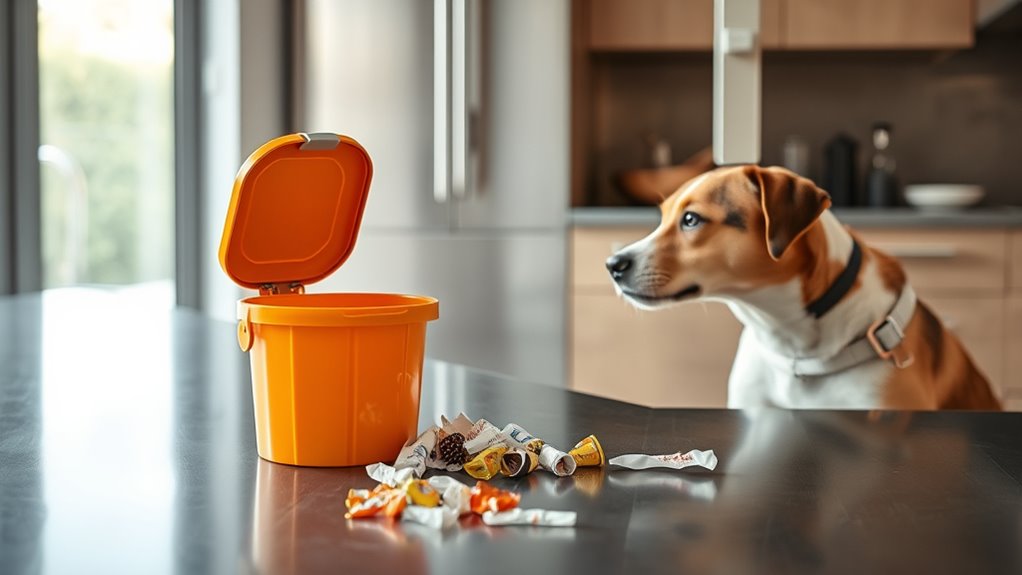
To prevent your pets from accessing garbage and food scraps, securing trash cans is essential. Proper trash containment keeps tempting leftovers out of their reach. To enhance safety, consider these steps:
- Use animal-proof trash cans with tight-fitting lids to prevent easy access.
- Store food securely in airtight containers, especially leftovers and scraps.
- Keep food storage areas off-limits and out of your pet’s reach, like high shelves or cabinets.
- Educating yourself about mental wellbeing can also help you stay attentive to your pet’s safety and behavioral needs. Being aware of behavioral cues can help prevent your pet from developing habits related to scavenging or overeating. Additionally, understanding household hazards and the importance of skincare patches in routine maintenance can guide you in creating a safer environment for your furry friends.
Frequently Asked Questions
How Often Should I Review My Home for Potential Hazards?
You should conduct home safety inspections regularly to keep your pet safe. The hazard review frequency depends on your household, but a good rule of thumb is to check monthly and after any home improvements or changes. Regular hazard reviews help you spot potential dangers early, preventing accidents. Stay vigilant and adapt your review schedule as needed to ensure your home remains a safe environment for your pet.
Are There Specific Safety Products Recommended for Pet-Proofing?
It’s amusing how we trust household items to be safe, yet pet-proofing gadgets prove otherwise. You should look into safety product brands specializing in pet-proofing, like corner protectors, outlet covers, and secure cabinets. These gadgets are designed to keep your curious pet safe, avoiding accidents. Investing in trusted pet-proofing products ensures peace of mind, knowing you’re actively protecting your furry friend from common household hazards with the best safety gadgets available.
What Signs Indicate My Pet Has Ingested a Toxic Substance?
If your pet shows signs of poisoning, you might notice behavioral changes like lethargy, vomiting, or difficulty breathing. Watch for other symptoms such as drooling, tremors, or seizures. These signs indicate your pet has ingested a toxic substance. If you see any of these, act quickly by contacting your veterinarian or emergency pet poison control. Prompt action can help guarantee your pet’s safety and health.
How Can I Pet-Proof Outdoor Areas Effectively?
Sometimes, a simple moment in your garden reveals overlooked dangers. To pet-proof outdoor areas, start with sturdy garden fencing that keeps pets away from hazards. Remove or secure outdoor plants that are toxic to animals, like lilies or azaleas. Regularly inspect the yard for sharp objects or chemicals. By creating a safe environment, you protect your pet from unexpected dangers while enjoying your outdoor space together.
What Should I Do if My Pet Gets Injured by a Household Hazard?
If your pet gets injured by a household hazard, stay calm and follow first aid steps like stopping bleeding with pressure or cleaning wounds gently. Call your veterinarian immediately and have emergency contacts ready. Keep your pet comfortable and prevent further injury. Monitoring their condition until professional help arrives is essential. Prompt action can make a big difference in their recovery, so don’t hesitate to seek expert advice quickly.
Conclusion
By pet-proofing your home, you create a safer environment for your furry friend. Imagine a curious puppy, happily exploring, but thanks to secure chemicals and hidden hazards, they’re protected from harm. Regularly check for small objects or toxic plants, and set up a designated play area. Taking these simple steps guarantees your pet stays safe and happy, giving you peace of mind as you enjoy your time together in a secure, hazard-free space.

